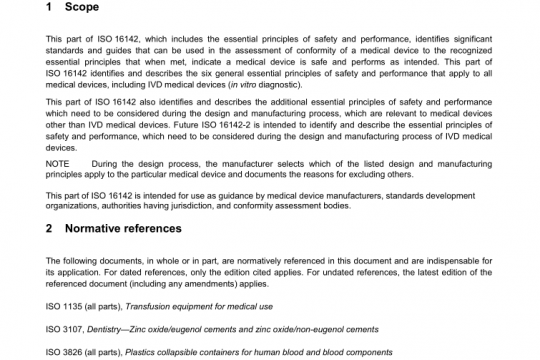AAMI SP9 pdf free download
AAMI SP9 pdf free download.Non-automated sphygmomanometers.
3 Definitions For the purposes of this standard, the following definitions apply. 3.1 aneroid manometer: Pressure-determining device using a mechanical indicating element or component. 3.2 calibration: Act or process of standardizing by determining the deviation of a measurement from an established standard of known accuracy (e.g., one traceable to the National Bureau of Standards). 3.3 Korotkoff sounds: Sounds heard over the artery when blood pressure is determined by the indirect (auscultatory) method. 3.4 manometer: Instrument for measuring the pressure of gases and vapors. 3.5 mercury gravity manometer: Pressure-determining device using a column of mercury as its indicating element. 3.6 outer container: Immediate/unit container (i.e., retail package) of a device intended for home or other unsupervised use. 3.7 sphygmomanometer: Instrument used for the indirect (noninvasive) measurement of arterial blood pressure. 3.8 stethoscope: Instrument for detecting and studying sound produced by the body; in the case of blood pressure measurement, for detecting Korotkoff sounds. 3.9 true zero: Position of the aneroid pointer or mercury column meniscus when a manometer is at zero differential pressure.4 Requirements 4.1 Labeling requirements 4.1.1 General In addition to federal regulations applicable to the labeling of all medical devices, the following requirements shall apply to devices within the scope of this standard. 4.1.2 Outer container The outer container of the device shall display information needed by the end user, including cuff size, and shall also display the statement “limited range,” if the manometer range is less than the “standard range” specified in 4.4.1.1 and 4.4.2.1. 4.1.3 Product literature Product literature shall accompany the device and shall include, but is not limited to, the following information: a) the manufacturer’s recommendations for calibration checks, cleaning, and care of instrument; b) any hazards associated with prolonged overinflation of the bladder; c) methods for determining malfunctions of the display device; d) the recommended sterilization procedures (when required); e) the methods for dealing with mercury spills (for mercury gravity sphygmomanometers); f) adequate instructions for use and operation; g) a statement concerning the need to consult a health care professional for interpretation of pressure measurements (for devices intended for home or other unsupervised use); h) the terms and conditions of the product warranty; i) information concerning available service centers; j) the accuracy of the sphygmomanometer; k) a statement indicating that the system may not meet its performance specifications if stored or used outside the manufacturer’s specified temperature and humidity ranges (the manufacturer’s specified ranges to be included in the statement).4.1.4 Cuff labeling The cuff shall be labeled or constructed to indicate the range of limb circumferences for which the cuff is intended and marked or constructed so that, when the cuff is applied to a limb, the markings or construction will indicate whether or not the cuff is the correct size. 4.2 Environmental performance and stability 4.2.1 Temperature Nonautomated sphygmomanometers and their accessories shall maintain the safety and performance characteristics specified in this standard after storage for 24 hours (h) at temperatures ranging from –34°C (–30°F) to 65°C (149°F) at a relative humidity not to exceed 85%. During operation, nonautomated sphygmomanometers and their accessories shall maintain the safety and performance characteristics specified in this standard at temperatures ranging from 0°C (32°F) to 46°C (115°F) at a relative humidity not to exceed 85%.AAMI SP9 pdf download.
Other IEC Standards
-

ANSI AAMI ISO 16142-1 pdf free download – non-IVD medical devices and guidance on the selection of standards
AAMI standards list DOWNLOAD -

ANSI AAMI ISO 16142-2 pdf free download – General essential principles and additional specifc essential principles
AAMI standards list DOWNLOAD


